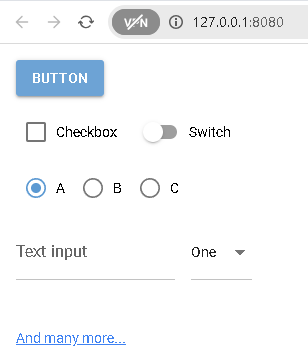NiceGUI is an easy-to-use, Python-based UI framework, which shows up in your web browser. You can create buttons, dialogs, Markdown, 3D scenes, plots and much more.
The project can be found on this GitHub repo.
pip install nicegui
Collecting nicegui
Downloading nicegui-1.4.21-py3-none-any.whl.metadata (9.4 kB)
...
Successfully installed aiofiles-23.2.1 aiohttp-3.9.4 aiosignal-1.3.1 bidict-0.23.1 docutils-0.19 fastapi-0.109.2
frozenlist-1.4.1 httptools-0.6.1 ifaddr-0.2.0 markdown2-2.4.13 multidict-6.0.5 nicegui-1.4.21 orjson-3.10.0
pscript-0.7.7 python-engineio-4.9.0 python-multipart-0.0.9 python-socketio-5.11.2 simple-websocket-1.0.0
starlette-0.36.3 uvicorn-0.29.0 vbuild-0.8.2 watchfiles-0.21.0 websockets-12.0 yarl-1.9.4The default demo example from the official webpage works fine.
This is the source code I used.
from nicegui import ui
from nicegui.events import ValueChangeEventArguments
def show(event: ValueChangeEventArguments):
name = type(event.sender).__name__
ui.notify(f'{name}: {event.value}')
ui.button('Button', on_click=lambda: ui.notify('Click'))
with ui.row():
ui.checkbox('Checkbox', on_change=show)
ui.switch('Switch', on_change=show)
ui.radio(['A', 'B', 'C'], value='A', on_change=show).props('inline')
with ui.row():
ui.input('Text input', on_change=show)
ui.select(['One', 'Two'], value='One', on_change=show)
ui.link('And many more...', '/documentation').classes('mt-8')
ui.run()I run with the python and you can see is visible in many places:
python test_001.py
NiceGUI ready to go on http://localhost:8080, http://x.x.x.x:8080, and http://x.x.x.x:8080The result is this:

You can find a lot of examples on the official GitHub repo.


